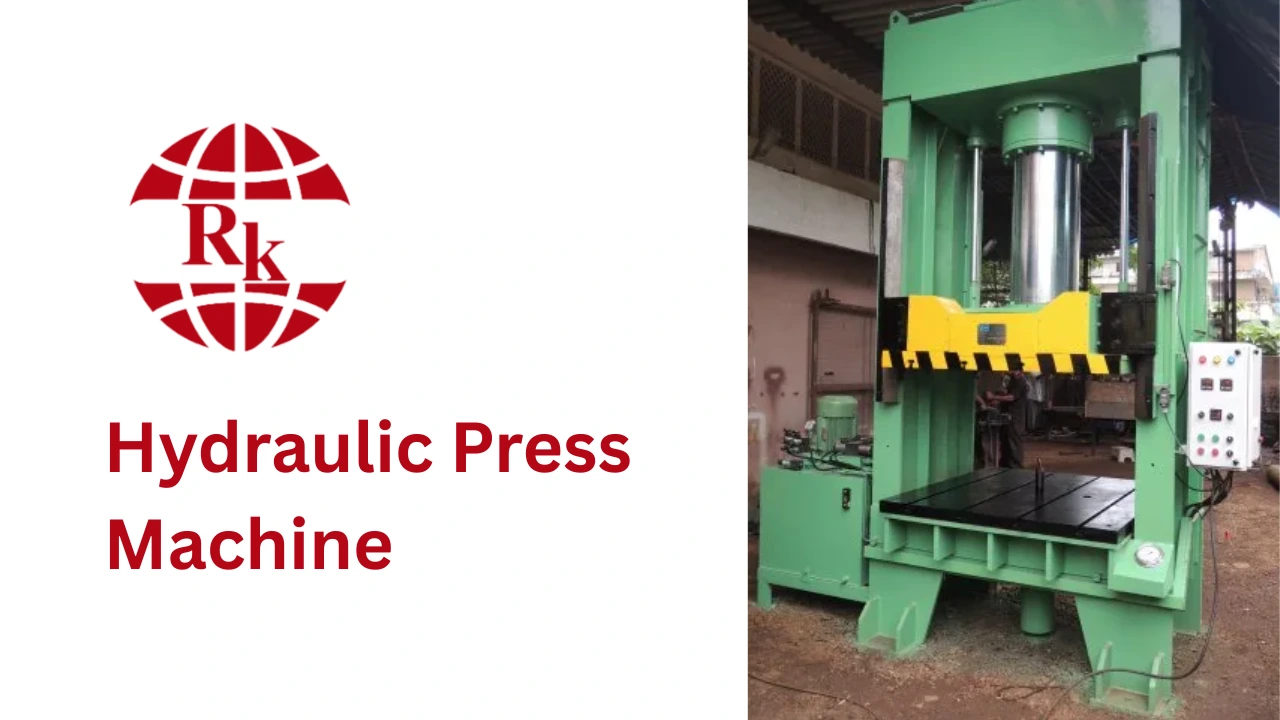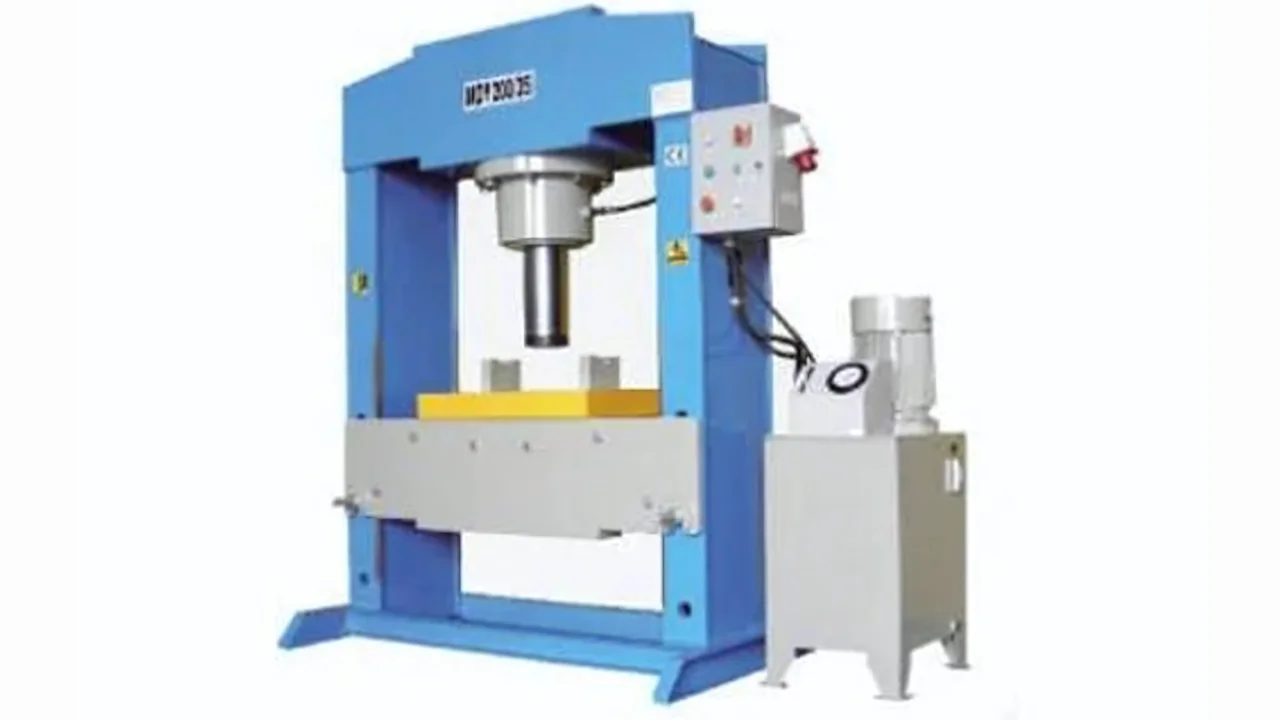A Hydraulic press machine is an important machine used in various industries for shaping, forming, and fabricating materials through the application of high-pressure hydraulic fluid. It is an indispensable machine for industries such as automotive, manufacturing, metalworking, and more. Radhey Krishan Industries, a leading hydraulic machine manufacturer, has been at the forefront of providing top-quality hydraulic press machines that offer superior performance and precision. Hydraulic press machine is available in various types of presses, such as the Industrial hydraulic press, H-frame hydraulic press, and C-frame hydraulic press and more, are designed to handle different industrial tasks. In this blog, we will explain about the working principle of a hydraulic press machine, detailed on how this machine operates. What is Hydraulic Press Machine A Hydraulic press is a kind of mechanical machine that uses liquid to transfer energy to shape and deform various types of metals. The hydraulic press’s ability to deliver large amounts of force with minimal input energy makes it a staple in heavy industries like automotive, aerospace, and metalworking. It works on Pascal’s principle. The machine is mainly used for uplifting the Application of smaller forces. Pascal’s principle states that the intensity of pressure in a static fluid is transmitted equally in all directions. Working Principle of a Hydraulic Press Machine The working principle of a hydraulic press machine is based on Pascal’s Law, which states that “pressure applied to an enclosed fluid is transmitted undiminished to all portions of the fluid and to the walls of its container.” Let’s break this down step by step to understand how this principle is applied in a hydraulic press. Hydraulic press machines are used to crush, molding and casting metals. This machine is used in industries such as automotive, metalworking, and manufacturing, where it is used to form and shape metal. The pressure generated by the rod, in turn, creates a vacuum which is released through ball bearings that are fitted on top of each cylinder. The piece then rotates on the moving cylinder while being pressed. Here, we briefly explain the working principle of H- Frame Hydraulic press Machine. 1. Hydraulic System Components: A typical hydraulic press machine comprises the following main components: 2. Pressure Generation: The operation begins with the hydraulic pump drawing fluid from the reservoir and pumping it into the hydraulic cylinder at high pressure. This fluid flows into the chamber, exerting pressure on the piston. 3. Force Application: As the pressure builds up within the hydraulic cylinder, the piston is forced to move. The amount of force that the piston can exert is directly proportional to the pressure in the fluid and the area of the piston, according to Pascal’s Law. The equation governing this force is: Force=Pressure×Area\text{Force} = \text{Pressure} \times \text{Area}Force=Pressure×Area Because hydraulic presses utilize the power of high-pressure fluid, even a small amount of input force can generate a significant amount of output force on the piston. This force is used to press, shape, or form the material placed in the press. 4. Compression and Shaping: The material to be shaped (such as metal, plastic, or rubber) is placed under the press’s upper or lower platen. As the piston moves down, the material is compressed between the upper and lower surfaces, thereby shaping it into the desired form. This is particularly useful in processes like metal stamping, die-cutting, and forging. 5. Returning the Piston: Once the desired shape is achieved, the hydraulic fluid is released from the cylinder through a control valve. This action allows the piston to return to its original position, ready for the next cycle. The fluid that is released is returned to the reservoir, ready for reuse in the next pressing operation. Why Hydraulic Press Machines Are So Effective The hydraulic press machine is known for its numerous advantages, making it the machine of choice for various applications: Radhey Krishan Industries: Your Trusted Partner in Hydraulic Press Solutions At Radhey Krishan Industries, we understand that every industry has unique requirements, and that’s why we specialize in custom hydraulic press machines tailored to meet your specific needs. Whether you’re looking for a H Frame hydraulic press for metalworking, or a smaller, precision press for delicate tasks, we have the expertise and equipment to manufacture and deliver. We are manufacturer and supplier of hydraulic press, various types of hydraulic press H frame hydraulic press, C frame Hydraulic frame, Straight Sided Hydraulic frame etc. Our hydraulic press machines are built with modern technology, ensuring long-term performance and reliability. As the best manufacturer of H- Frame hydraulic press machines, we are dedicated to providing exceptional customer support and helping you achieve optimal results in your production processes. Conclusion The hydraulic press machine operates on a simple yet highly effective principle: Pascal’s Law. By utilizing the force of high-pressure fluid, hydraulic presses are capable of performing a variety of tasks, from metal forming to plastic molding, with efficiency and precision. At Radhey Krishan Industries, we continue to provide best quality hydraulic press machines that meet the demanding needs of industries worldwide. If you’re looking for a reliable hydraulic press machine, look no further than Radhey Krishan Industries. Our extensive experience and commitment to quality ensure that we can help you achieve greater productivity and efficiency in your manufacturing units. Contact us today for more information.
A Industrial Hydraulic press is a machine that uses hydraulic force to shape, mold, or compress materials. It operates on Pascal’s principle, where pressure applied to a confined fluid is transmitted equally in all directions. Working involves a hydraulic cylinder, piston, and fluid to generate immense pressure. Safety is crucial, requiring proper training, maintenance, and protective gear. Advantages include high efficiency, precision, and durability, while disadvantages involve high initial costs and potential oil leaks. Applications span industries like automotive, aerospace, and manufacturing. Radhey Krishan Industries provides high-quality hydraulic presses for diverse industrial needs. Also Read Us: Top 5 Hydraulic Press Machine Manufacturer in India What is a Hydraulic Press Machine? A hydraulic press is a kind of mechanical machine that uses liquid to transfer energy to shape and deform various types of metals. It works on Pascal’s principle. The machine is mainly used for uplifting the Application of smaller forces. Pascal’s principle states that the intensity of pressure in a static fluid is transmitted equally in all directions. The hydraulic presses, commonly provided by hydraulic press manufacturers, contains three parts: the mainframe, the power system, and the hydraulic control system. In this, the pressure in a liquid is applied by a pump that works like a pump and creates mechanical force. Various types of presses, such as the industrial hydraulic press, H-frame hydraulic press, and C-frame hydraulic press, are designed to handle different industrial tasks. Hydraulic Press Machine Working : Generally, multiple small rams are used rather than one large ram because it is easy to control the thrust forces as compared to large sizes. The number of rams depends upon the working load. The hydraulic pressure of fluid drives the ram. A pump and hydraulic accumulator are used to supply the high-pressure liquid. The Hydraulic accumulator works as a junction point between the pump and the rams. When the press is stationary, a hydraulic accumulator stores the high-pressure liquid. When strong thrust is necessary for operation, a hydraulic press is used. This working mechanism is typical for machines like the 20 ton hydraulic press, 50 ton hydraulic press, and even larger presses. Working of a Hydraulic Press A hydraulic press functions through a series of steps: Safety Measures for Hydraulic Press Machines Hydraulic presses operate under high pressure and can pose serious risks if not handled properly. Below are some essential safety measures: Advantages of Hydraulic Press Machine : As compared to the manual machine the hydraulic press machine has a lighter weight with a small number of parts used for forming the shapes of sheet metal. The main advantages of Hydraulic press machines are the following: Disadvantages: Applications: Why Choose a Hydraulic Press? When selecting a pressing solution, a hydraulic press stands out due to its numerous advantages. Here’s why you should choose a hydraulic press: Conclusion: Hydraulic presses are an essential part of various industries due to their high efficiency, versatility, and precision. While they offer significant advantages, proper safety measures must be taken to prevent accidents and ensure smooth operation. Understanding their working principles, benefits, and applications can help businesses choose the right hydraulic press for their specific needs. For high-quality hydraulic presses, Radhey Krishan Industries provides top-of-the-line machinery with advanced features and excellent performance. Contact us today for the best hydraulic press solutions tailored to your industrial requirements!



